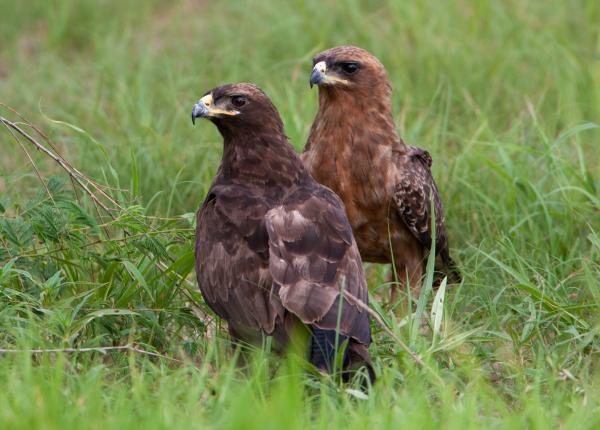Did You Know?
- Wahlberg’s Eagles are Africa’s smallest eagles.
- They are also one of the few truly migratory African raptors.
- There are no recognized subspecies of this eagle.
How The Peregrine Fund is Helping
The Peregrine Fund is monitoring pairs of Wahlberg's Eagle that breed in East and southern African savannas. Our team of biologists GPS track their movements to non-breeding areas in Central Africa. This will help understand where they congregate outside the breeding period, and what is driving their declines. Additionally, in Kenya, our scientists are working hard to learn about and protect all raptors and their habitats. Through environmental education efforts, we are also working to put a stop to the common practice of poisoning carcasses to kill large predators, which also kills a host of wildlife including vultures, eagles, and other scavenging birds. These efforts will certainly benefit all raptors of the region.
Meanwhile, our efforts in scientific research, habitat conservation, education, and community development help conserve birds of prey around the world. We also supply literature to researchers from our avian research library, which helps scientists around the world gather and share important information on raptor conservation. We also run the Global Raptor Impact Network which gives raptor researchers tools to more efficiently conduct their own studies while contributing to a global program. GRIN also provides citizen scientists a way to participate in raptor science and conservation.
Learn more about our work in Africa to conserve raptors.
Where They Live
Wahlberg's Eagles range far and wide across the African continent, though they tend to avoid areas of dense forest ore very dry regions. Instead, these lovely raptors make their home in wooded savanna and woodlands, riparian habitats, cultivated areas, and thornbush. They seem to prefer spending time in flat terrain as opposed to more hilly or mountainous areas. Throughout much of its range, it is found from sea level to about 1,800 meters above sea level.
What They Do
Wahlberg's Eagles, like many raptors, spend a lot of time soaring high in the sky. Biologists have observed them congregating in large number, alongside Black Kites and Tawny Eagles, particularly after heavy rains.
Why They Need our Help
This eagle is one of the more common eagles found in sub-Saharan Africa. It is categorized as a species of Least Concern, which means that conservationists aren't too worried about the health of this species' populations. However, this doesn't mean that this eagle isn't facing threats. It has suffered some losses from poisoning and hunting, and disturbance and felling of tall trees also affect this species negatively on a local basis.
What They Eat
This eagle has a long list of prey animals it will hunt. It feeds on a plethora of different mammals including bush squirrels, bats, small mongooses, and young hares. It will also take small snakes, frogs, and other birds, both big and small, including larks, bustards, and guineafowl. It will feed upon beetles and grasshoppers, too. However, across much of its range, it seems to have a particular taste for lizards.
When hunting, it might stand on a perch to keep an eye out for a passing meal, or it will stoop down on its prey from the air, or just after its quarry in a speedy aerial pursuit.
Nests, Eggs, and Young
Both the male and female Wahlberg's Eagles work together to build their small stick nests, which they line with green leaves and place high in a fork of a large tree.. When the time is right, the female will lay just one single egg, though some females have been known to lay up to two eggs. Once the eggs are laid, the female will take on most of the incubation duties. She will spend most of the following 44 days or so sitting on her egg to keep it warm and safe. During this time, and after the nestling hatches, the male will be responsible for finding and bringing enough prey to feed his family. The young nestling will remain in the nest for about 10 weeks before it is ready to fly for the first time.
Even on the rare occasion when a female lays two eggs and both eggs hatch, still only one nestling survives. This is because the older, stronger nestling will kill the smaller, weaker one.
Wahlberg's Eagle and the World Center for Birds of Prey
Though across the world from Wahlberg's Eagles, The World Center for Birds of Prey offers fun ways to learn about raptors of all kinds. Interactive activities, tours, interesting videos and a children's room with activities from coloring sheets and quizzes to costumes and a touch table are available for the curious mind. We also have several different birds of prey on display year-round, including several eagle species! If you visit you will be rewarded with an opportunity to meet Fancy, our resident Ornate Hawk-eagle, and Grayson a Harpy Eagle. At the visitor center, you will see these amazing birds of prey, and others, up close in our outdoor aviary. Our knowledgeable staff is on hand to answer any questions you may have.
References:
Global Raptor Information Network. 2022. Species account: Wahlberg's Eagle Hieraaetus wahlbergi. Downloaded from http://www.globalraptors.org on 25 Aug. 2022
Kemp, A. C. and G. M. Kirwan (2020). Wahlberg's Eagle (Hieraaetus wahlbergi), version 1.0. In Birds of the World (J. del Hoyo, A. Elliott, J. Sargatal, D. A. Christie, and E. de Juana, Editors). Cornell Lab of Ornithology, Ithaca, NY, USA. https://doi.org/10.2173/bow.waheag3.01










